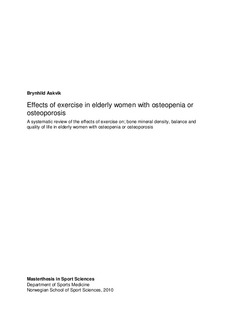Effects of exercise in elderly women with osteopenia or osteoporosis: a systematic review of the effects of exercise on; bone mineral density, balance and quality of life in elderly women with osteopenia or osteoporosis
Master thesis
Permanent lenke
http://hdl.handle.net/11250/171510Utgivelsesdato
2010Metadata
Vis full innførselSamlinger
Sammendrag
Background: Exercise for persons suffering from osteoporosis is widely known to have positive effects. The type of exercises that influences; a) Bone mineral density (BMD); b) Balance; and c) Quality of life (QOL) is still questionable.
Objectives: To determine the effects of different exercise types on; a) BMD; b) Balance; and c) QOL in osteoporotic elderly women.
Search method: PubMed; Cochrane Library; OvidMEDLINE; and EMBASE (01.01.2000-25.01.2010); and reference list of articles.
Selection criteria: Randomized controlled trials comparing exercise and control groups and/ or comparing different types of exercise. Criteria for the subjects in the selected studies were women aged 65-85 diagnosed with osteopenia or osteoporosis (using the World Health Organization (WHO) definitions).
Main results: Thirteen studies involving 553 subjects were included. Two studies, involving 258 subjects, investigated the effects of exercise on BMD. No significant increase in BMD was found in any exercise type. Ten studies, involving 553 subjects, investigated the effects of exercise on balance. Improvement was found in; weight bearing exercise; resistance exercise; osteoporosis specific exercise; and balance exercise. Two studies, involving 178 subjects, investigated the effects of exercise on QOL. Resistance exercise and weight bearing exercise improved QOL. No improvement was found in osteoporosis specific exercise.
Conclusions: None of the exercise types showed increase in BMD in elderly women with low bone mass. Resistance exercise; weight bearing exercise; osteoporosis specific exercise; and balance exercise improve balance. Resistance exercise; and weight bearing exercise improve QOL.
Beskrivelse
Masteroppgave – Norges idrettshøgskole, 2010.
